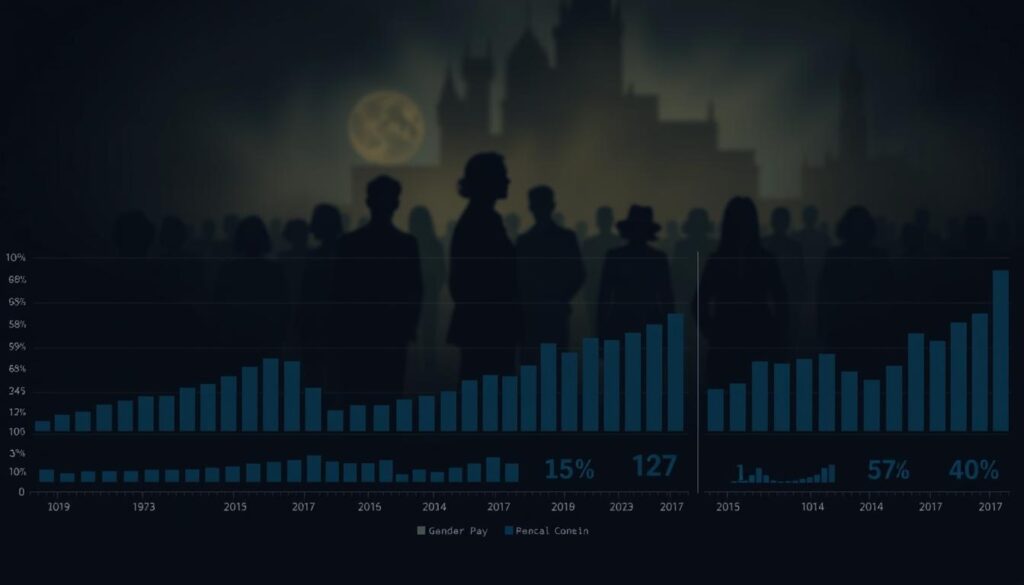The issue of unequal pay has been a big problem in the United States. It affects not just people but also the whole economy.
In 2023, the U.S. Census Bureau found something important. Full-time, year-round working women made 83% of what men made. This shows how big the challenge still is.
This pay gap has big effects. It’s important to know why it happens and what it means. This way, we can find good ways to fix it.
Key Takeaways
- The pay gap between men and women is a long-standing issue in the United States.
- Women working full-time, year-round earn 83% of what men earn.
- The gap affects not only individuals but also the broader economy.
- Understanding the causes is crucial for developing effective solutions.
- The issue has significant implications for women, families, and society.
The Current State of the Gender Wage Gap
The gender wage gap is a big problem in the United States. Women made 85% of what men made in 2024, a Pew Research Center found. This gap is seen in many jobs and industries.
Recent Statistics in the United States
Recent data shows the wage gap is still big. Women are paid less than men in almost every job. In 2023, women’s earnings were 82% of men’s, the Bureau of Labor Statistics said.
Variations by Industry and Occupation
The pay gap changes a lot by job and industry. Women in STEM jobs have a smaller gap than those in non-STEM jobs. But, even in STEM, women still earn less than men.
Changes Over the Past Decade
In the last ten years, the gender wage gap has slowly gotten smaller. But, the progress is slow. Janet Yellen, former Chair of the Federal Reserve, once said, “The gender pay gap is not just a women’s issue; it’s an economic issue that affects us all.”
“Equal pay is not just a women’s issue, it’s a business issue, an economic issue, and a matter of simple fairness.”
Historical Context: The Evolution of Pay Inequality
The history of pay inequality is complex, spanning centuries. It has been shaped by social, economic, and cultural factors. To grasp the current gender pay gap, we must look at key milestones and cultural shifts.
Women’s Entry into the Workforce
Women’s entry into the workforce has greatly influenced pay inequality. At first, women held low-paying jobs with few chances for growth. The Fair Labor Standards Act of 1938 made things worse by excluding jobs where Black workers were common.

Key Historical Milestones in Pay Equity
There have been important steps towards pay equity. The Equal Pay Act of 1963 was a big step. Yet, despite this law, pay gaps remained.
“The wage gap is not just a women’s issue; it’s an economic issue. When women are not paid fairly, it affects not just their families but the overall economy.”
Shifting Cultural Attitudes About Women’s Work
Cultural views on women’s work have changed a lot. As more women joined the workforce, society started to see their value.
| Year | Women’s Earnings as a % of Men’s |
|---|---|
| 1960 | 60% |
| 1980 | 70% |
| 2000 | 76% |
Understanding these historical facts is key to closing the gender pay gap. By looking back, we can tackle today’s disparities and aim for a fairer future.
Understanding the Gender Wage Gap Men Women Pay
It’s important to understand the gender wage gap to tackle pay inequality. The gap shows the difference in what men and women earn.
Defining the Gender Pay Gap
The gender pay gap is the earnings difference between men and women. In the U.S., women earn about 82 cents for every dollar men make.
Controlled vs. Uncontrolled Gap Measurements
There are two ways to measure the gender pay gap. The uncontrolled gap shows the overall earnings difference. The controlled gap adjusts for job type and experience.
Common Misconceptions About Wage Inequality Statistics
Many myths surround the gender pay gap. Some think women’s choices or education levels cause it. But research shows these aren’t the main reasons.
The “Women’s Choices” Argument
Some believe women’s career choices or family care lead to the pay gap. While these factors matter, they don’t explain the whole gap.
The Education Gap Myth
Another myth is that education levels cause the pay gap. But studies show a gap remains even when education is equal.
| Category | Men’s Earnings | Women’s Earnings | Pay Gap |
|---|---|---|---|
| Overall | $1 | $0.82 | 18% |
| College Educated | $1.20 | $1.00 | 17% |
| Non-College Educated | $0.80 | $0.65 | 19% |
For more on the gender pay gap, check out Pew Research.
Key Factors Contributing to Pay Disparity Between Genders
The pay gap between men and women comes from many factors. Knowing these is key to fixing pay inequality.
Occupational Segregation
Occupational segregation is a big issue. Women often work in jobs that pay less. Women of color are especially hit hard, earning 64 cents for every dollar a white, non-Hispanic man makes.

Work Experience and Career Interruptions
Work experience and career breaks also matter. Women often take time off for family, which can hurt their pay and career growth.
Education and Skill Differences
Even though women get more education, pay gaps remain. This is because women are less likely to work in high-paying STEM fields.
Negotiation Disparities
Negotiation skills also play a part. Women are less likely to ask for higher pay. When they do, they might face penalties, leading to lower salaries and fewer promotions.
Workplace Discrimination and Bias
Discrimination and bias at work also affect women’s pay. This can show up in unfair hiring, promotions, and opportunities.
| Factor | Impact on Pay Gap |
|---|---|
| Occupational Segregation | Concentrates women in lower-paying jobs |
| Work Experience and Career Interruptions | Impacts earning potential and career advancement |
| Education and Skill Differences | Underrepresentation in high-paying STEM fields |
| Negotiation Disparities | Results in lower salaries and reduced career advancement |
| Workplace Discrimination and Bias | Unequal access to promotions and opportunities |
To close the pay gap, we need a broad approach. By tackling these issues, we can move towards fairer pay for everyone.
The Motherhood Penalty and Fatherhood Bonus
Parenthood changes the career paths of men and women. Women often face a motherhood penalty, which means they earn less after having kids. On the other hand, men might get a fatherhood bonus, where they earn more and advance faster in their careers.
Impact of Parenthood on Women’s Earnings
Mothers who work feel a lot of pressure to take care of their homes. Those with kids under 18 often feel this pressure the most. This can stop them from moving up in their jobs and earning more.
Career Advancement Challenges for Working Mothers
Working mothers face many hurdles in their careers. These include:
- Balancing work and family duties
- Less career options because of childcare
- Being seen differently at work because they’re mothers
How Fatherhood Affects Men’s Compensation
Being a father can actually help men in their careers. They might be seen as more reliable and dedicated. This can lead to better pay and more opportunities.
Work-Life Balance Policies and Their Effects
Work-life balance policies can help even things out. These include flexible hours, leave for parents, and support for caregivers. By creating a better work environment, companies can help close the pay gap and support equal pay for all.
Intersectionality: Gender Wage Gap by Race
The gender wage gap is made worse by racial discrimination. This creates a bigger gap for women of different races. It’s important to understand how these factors affect earnings.
Looking at the gender wage gap, race adds another layer of complexity. Women of color face a double wage gap. They deal with both gender and racial discrimination at work.
Black Women and the Double Wage Gap
Black women are hit hard by the wage gap. They earn less than white women and much less than white men. This shows we need specific solutions.
Hispanic and Latina Women’s Earnings
Hispanic and Latina women also face big wage gaps. They earn less than white women and even less than white men. Limited education and job choices add to this gap.
Asian American Women’s Pay Disparities
Some data shows Asian Americans might earn as much as or more than whites. But this isn’t true for all Asian American women. It’s key to look at specific groups.
Native American Women’s Wage Inequality
Native American women have some of the biggest wage gaps. They face barriers like poor education and job chances. This lowers their earnings.
Compounding Factors of Discrimination
The wage gap for women of color is worsened by many factors. These include occupational segregation, limited career advancement opportunities, and direct discrimination. We need a broad approach to tackle these issues.
It’s vital to understand how gender and race intersect in the wage gap. By tackling the unique challenges faced by women of color, we can strive for a fairer society.
Economic and Social Impacts of the Gender Pay Gap
The gender pay gap has big effects on women’s money, their families, and the whole economy. Wage inequality statistics show it touches many parts of society.
Effects on Retirement Security and Wealth Accumulation
The pay gap leads to wealth gaps. Women are 5 to 8 times more likely to face job loss due to caregiving. This makes it hard for them to build wealth and plan for retirement.
Impact on Families and Children
When women earn less, families make less money. This can stop them from saving for their kids’ education and health. The pay gap can harm family life and kids’ chances for the future.
Broader Economic Consequences
A big gender pay gap hurts the economy too. Closing the gender pay gap could help the economy grow. It would give women and their families more money to spend.
Psychological Effects of Pay Inequality
Pay inequality can hurt women’s mental health. It can make them less happy at work and more stressed. Fixing the pay gap is key to a fair and healthy work place.
Looking at the gender pay gap’s effects, it’s clear that closing the gender pay gap is vital. It’s not just fair; it’s also good for the economy.
Gender Pay Gap Legislation and Policy Initiatives
The gender pay gap has sparked many policy efforts to close it. Lawmakers and advocates are pushing for new laws to tackle this issue.
The Equal Pay Act and Its Limitations
The Equal Pay Act of 1963 banned wage discrimination based on gender. Yet, it has its limits. It lets for pay differences based on other factors like merit or seniority. This has limited its power to close the pay gap.
“The wage gap is not just a women’s issue; it’s an economic issue that affects us all.” –
State-Level Pay Equity Laws
Without a strong federal law, states have stepped up with their own pay equity laws. These laws aim to protect against wage discrimination. For example, some states require employers to share pay information upon request.
| State | Pay Equity Law | Key Provision |
|---|---|---|
| California | Fair Pay Act | Prohibits wage differentials based on gender, race, or ethnicity |
| Massachusetts | Pay Equity Act | Requires equal pay for comparable work |
| New York | Achieve Pay Equity | Prohibits wage discrimination based on gender |
Proposed Federal Legislation
Several federal bills aim to tackle the gender pay gap. The Paycheck Fairness Act and the Raise the Wage Act are two key examples. These bills aim to strengthen equal pay laws and increase wage transparency.
Pay Transparency Requirements
Pay transparency is becoming a key strategy to fight wage discrimination. Laws now require employers to share pay ranges for job postings or upon request. This helps spot and fix pay disparities.
Effectiveness of Current Legal Protections
Current laws have made progress, but more is needed for true pay equity. Challenges include enforcing these laws and tackling the complex reasons behind the pay gap.
Corporate Strategies for Closing the Gender Pay Gap
Closing the gender pay gap needs a mix of efforts, with companies at the forefront. They are using different strategies to ensure fair pay and a welcoming workplace.
Equal Pay for Equal Work Initiatives
One key strategy is equal pay for equal work. This means checking and changing pay systems to make sure men and women get the same pay for the same job. PayScale says, “The key to achieving pay equity is transparency and a commitment to fairness.”
Salary Audit Practices
Regular salary audits are essential to spot and fix pay gaps. Big names like Google and Microsoft have done big audits to find and fix pay differences. A report says, “Companies that do regular salary audits are more likely to find and fix pay gaps.”
Family-Friendly Workplace Policies
Creating family-friendly workplace policies is another smart move. These include flexible work hours and parental leave. They help employees manage work and family life better, which can help close the pay gap. As
“The companies that are most successful in closing the pay gap are those that offer generous parental leave and flexible work arrangements.”
Mentorship and Leadership Development Programs
Mentorship and leadership development programs are also key. They help women move up in their careers, which can help narrow the pay gap. Companies like IBM have started such programs to support women’s career growth.
Case Studies of Successful Corporate Approaches
Many companies have successfully used these strategies. For example, Salesforce did a detailed pay equity check and made changes to close the gap. These examples show that with dedication and the right plans, companies can make big strides in closing the gender pay gap.
Global Perspectives: How the US Compares Internationally
The United States is working to close its gender pay gap. Meanwhile, other countries have made big steps towards pay equality. Looking at these examples can teach us how to bridge the gap.
Countries Leading in Pay Equity
Some countries are at the forefront of pay equality. For example, Iceland has passed laws to ensure equal pay. This makes it a leader in transparency.
Successful International Approaches
Sweden and Norway have introduced family-friendly policies. These include generous parental leave and flexible work hours. These changes help create a fairer work environment for everyone.
Cultural Factors Affecting Global Wage Gaps
Cultural views on gender and work play a big role in pay gaps. In some places, old gender roles lead to bigger pay differences. It’s key to understand these cultural aspects to find solutions.
Lessons from Nordic Countries
Nordic nations like Denmark and Finland have made great strides. They focus on gender equality and have strong parental leave policies. Their approach is a blueprint for others.
Looking at the global scene shows the need for varied strategies. By studying international methods and cultural impacts, the US can find its own way to equal pay.
Conclusion: The Path Forward to Pay Equity
Closing the gender pay gap needs a team effort from government, businesses, and individuals. We must tackle the complex issues causing pay disparities. Equal pay for equal work is key in this fight.
The Equal Pay Act is a big step towards fair pay. But, we still have to tackle the real reasons for the pay gap. These include job segregation, negotiation gaps, and workplace bias.
Companies can help by doing salary checks and supporting family-friendly policies. These steps can make workplaces more inclusive and fair for everyone.
Getting to pay equity will take ongoing work from everyone. By joining forces and spreading awareness, we can build a fairer society. A place where everyone has a chance to thrive.





